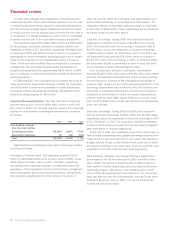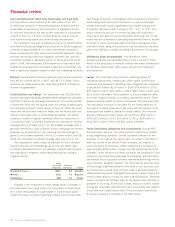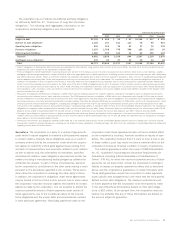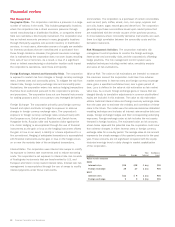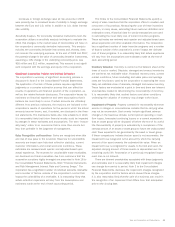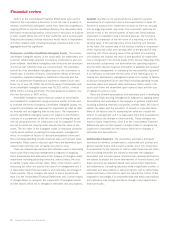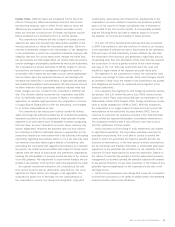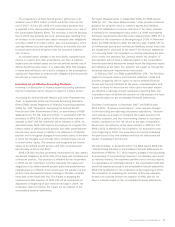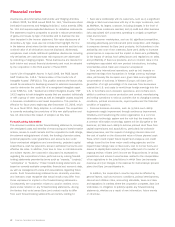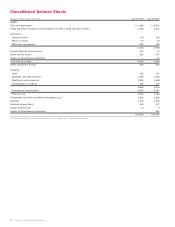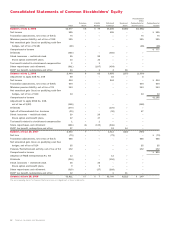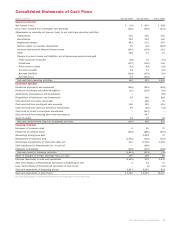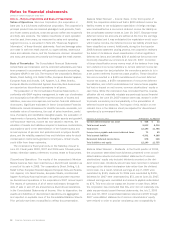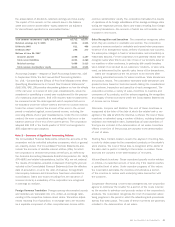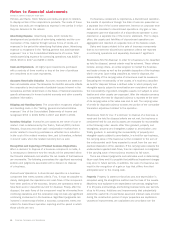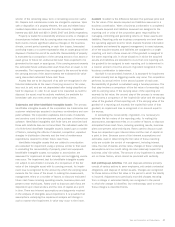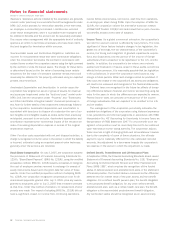Sara Lee 2008 Annual Report Download - page 40
Download and view the complete annual report
Please find page 40 of the 2008 Sara Lee annual report below. You can navigate through the pages in the report by either clicking on the pages listed below, or by using the keyword search tool below to find specific information within the annual report.Financial review
Disclosures about Derivative Instruments and Hedging Activities
In March 2008, the FASB issued SFAS No. 161, “Disclosures about
Derivative Instruments and Hedging Activities,” which amends SFAS
No. 133 and requires expanded disclosure for derivative instruments.
The statement requires companies to provide a tabular presentation
of gains and losses by type of derivative and to disclose the line
item impacted in the income statement. Fair value disclosures of
derivatives, by type, must also be included that highlight the line
in the balance sheet where the fair values are recorded and the total
notional value of all derivatives must be disclosed. Additionally,
companies must include additional qualitative disclosures including
why derivatives are used and what risk exposures are addressed
by executing a hedging program. These disclosures are required for
both interim and annual financial statements and must be adopted
by the corporation in the third quarter of fiscal 2009.
Useful Life of Intangible Assets
In April 2008, the FASB issued
Staff Position No. 142-3, “Determination of the Useful Life of
Intangible Assets” (FSP142-3). This position amends the factors that
should be considered in developing renewal or extension assumptions
used to determine the useful life of a recognized intangible asset
under SFAS No. 142, “Goodwill and Other Intangible Assets.” FSP
142-3 applies to both intangible assets that are acquired individually
or with a group of other assets as well as intangible assets acquired
in business combinations and asset acquisitions. This position is
effective for fiscal years beginning after December 15, 2008, which
for us is fiscal 2010. Early adoption is not allowed. The corporation
is currently evaluating the provisions of this new staff position and
has not determined the impact of adoption at this time.
Forward-Looking Information
This document contains certain forward-looking statements, including
the anticipated costs and benefits of restructuring and transformation
actions, access to credit markets and the corporation’s credit ratings,
the planned extinguishment of debt, the funding of pension plans,
potential payments under guarantees and amounts due under
future contractual obligations and commitments, projected capital
expenditures, cash tax payments, pension settlement amounts and
effective tax rates. In addition, from time to time, in oral statements
and written reports, the corporation discusses its expectations
regarding the corporation’s future performance by making forward-
looking statements preceded by terms such as “expects,” “projects,”
“anticipates” or “believes.” These forward-looking statements are
based on currently available competitive, financial and economic data,
as well as management’s views and assumptions regarding future
events. Such forward-looking statements are inherently uncertain,
and investors must recognize that actual results may differ from
those expressed or implied in the forward-looking statements.
Consequently, the corporation wishes to caution readers not to
place undue reliance on any forward-looking statements. Among
the factors that could cause Sara Lee’s actual results to differ
from such forward-looking statements are factors relating to:
•Sara Lee’s relationship with its customers, such as (i) a significant
change in Sara Lee’s business with any of its major customers, such
as Wal-Mart, its largest customer, including changes in the level of
inventory these customers maintain; and (ii) credit and other business
risks associated with customers operating in a highly competitive
retail environment;
•The consumer marketplace, such as (iii) significant competition,
including advertising, promotional and price competition, and changes
in consumer demand for Sara Lee’s products; (iv) fluctuations in the
availability and cost of raw materials, Sara Lee’s ability to increase
product prices in response and the impact on Sara Lee’s profitability;
(v) the impact of various food safety issues and regulations on sales
and profitability of Sara Lee products; and (vi) inherent risks in the
marketplace associated with new product introductions, including
uncertainties about trade and consumer acceptance;
•Sara Lee’s international operations, such as (vii) impacts on
reported earnings from fluctuations in foreign currency exchange
rates, particularly the European euro, given Sara Lee’s significant
concentration of business in Western Europe; (viii) Sara Lee’s
generation of a high percentage of its revenues from businesses
outside the U.S. and costs to remit these foreign earnings into the
U.S. to fund Sara Lee’s domestic operations; and (ix) Sara Lee’s
ability to continue to source production and conduct manufacturing
and selling operations in various countries due to changing business
conditions, political environments, import quotas and the financial
condition of suppliers;
•Previous business decisions, such as (x) Sara Lee’s ability
to generate margin improvement through continuous improvement
initiatives and transitioning the entire organization to a common
information technology system and the risk that the transition to
a common information technology system will be disruptive to the
business; (xi) Sara Lee’s ability to achieve planned cash flows from
capital expenditures and acquisitions, particularly its worldwide
bakery business, and the impact of changing interest rates and
the cost of capital on the discounted value of those planned cash
flows, which could impact future impairment analyses; (xii) credit
ratings issued by the three major credit rating agencies and the
impact these ratings have on Sara Lee’s cost to borrow funds and
access to capital/debt markets; (xiii) the settlement of a number of
ongoing reviews of Sara Lee’s income tax filing positions in various
jurisdictions and inherent uncertainties related to the interpretation
of tax regulations in the jurisdictions in which Sara Lee transacts
business; and (xiv) changes in the expense for multi-employer pension
plans that Sara Lee participates in.
In addition, the corporation’s results may also be affected by
general factors, such as economic conditions, political developments,
interest and inflation rates, accounting standards, taxes and laws
and regulations in markets where the corporation competes. Sara Lee
undertakes no obligation to publicly update any forward-looking
statements, whether as a result of new information, future events
or otherwise.
38 Sara Lee Corporation and Subsidiaries


